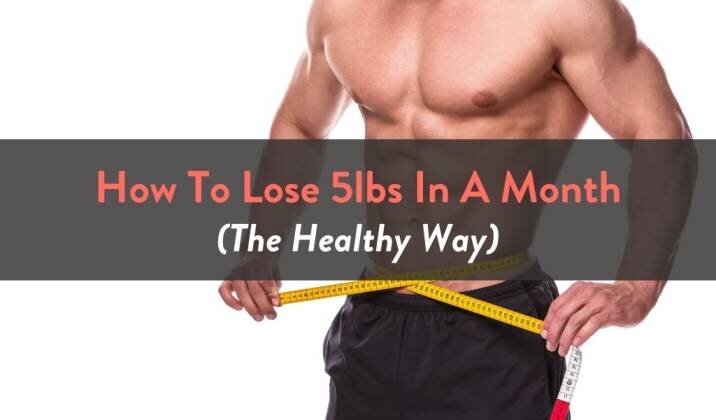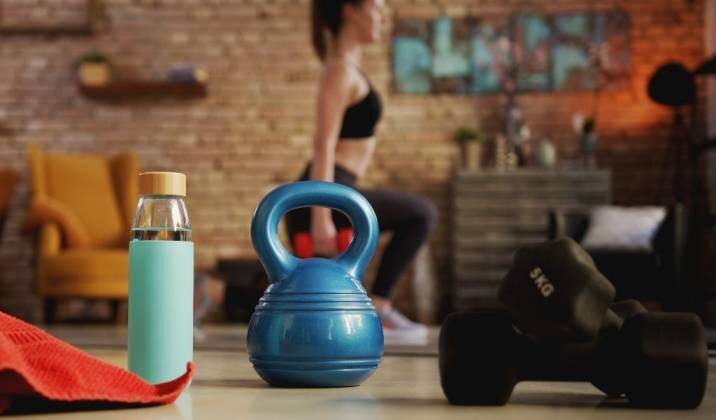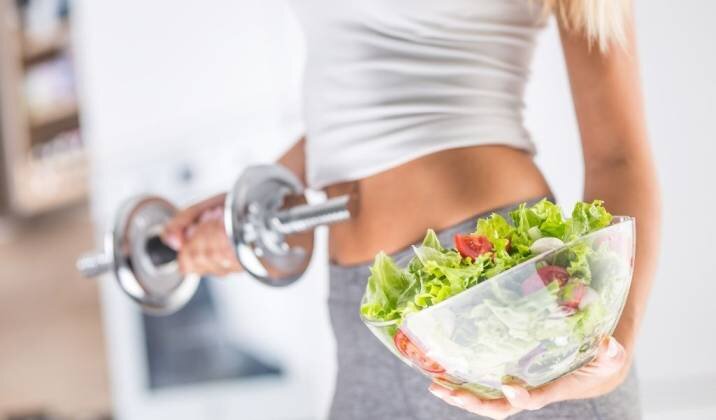Diet to Lose 5 Lbs in 3 Days

Losing weight is a goal that many people want to achieve. However, it's important to lose it in a way that not only values your physical health but also your mental and emotional state.
To lose 5lbs in a month in a healthy and sustainable way, you need to focus on the three main areas—nutrition, training and lifestyle. By eating in a calorie deficit, following an effective training plan and ensuring that you're getting enough rest and sleep, losing 5lbs in a month can be done.
Need a workout program? Get 3 free workouts on Fitbod right now.
Is A Month A Reasonable Time To Lose 5lbs?

People often choose crazy short and unrealistic time frames to reach their weight loss goal. However, if your goal is to lose 5lbs within the time span of a month, then we're happy to say that that is a realistic and reasonable goal to choose. It means that you won't need to resort to fad diets, dangerous restrictions or yo-yo diets. Dropping 5lbs from your weight in a month's time can be done in a slow and steady but sustainable manner.
Related Article: How to Eat More Calories And Lose Weight: Is It Possible?
How Weight Loss Works
First, we need to cover how losing weight actually works. There is a simple science to weight loss that can be summed up by the formula of calories in versus calories out. Let's break this down further.
A calorie is a unit of energy. It's what fuels your body and gives it the energy to perform. The more active you are, the more calories you'll need. Everybody has a certain number of calories that they need just to live. This means that if you were lying in bed all day and night and not moving, your body still needs calories for functions such as breathing and blinking. Yes, even blinking requires energy! The number of calories necessary for this is referred to as your BMR or basal metabolic rate.
Now, for most of us, we're doing much more than just lying in bed. We're walking around, climbing stairs, eating food, exercising and so forth. Including this extra activity to our daily calorie burning rate, we get our TDEE, total daily energy expenditure. This is basically your BMR + the estimated number of calories you use on a daily basis. Of course, you won't use the exact number of calories each day, but take the average number.
Your TDEE differs depending on your lifestyle. Everything is taken into account, such as the type of exercise you do, the intensity of that exercise and even if you work a desk job where you're sitting for most of the day or if you work on your feet performing hard labour. It is an individual number which is why someone who may weigh the same as you and have the same height might be given a completely different TDEE from you.
To work out your TDEE, there are many online calculators that you can use. All you need to do is complete the questionnaire and it'll give you your number. Now, it may not be completely accurate but that's okay. We just need a starting number to work with and based on the results you generate, you can then adjust accordingly. But we'll get to that next.
Related Article: Are Exercise Bikes Good For Weight Loss?
HOW TO DETERMINE YOUR CALORIE DEFICIT
Once you have your TDEE, now it's time to work out your daily calorie number so that you can be in a deficit.
This means that you'll be consuming fewer calories than what your body burns, which will result in weight loss.
People may think that a greater calorie deficit will results in faster fat loss and that is true.
However, the greater the deficit, the higher the chances that you'll become extremely hungry and might binge or just be miserable. It also means a higher chance that you'll sacrifice muscle instead of fat. Remember, slow and steady wins the race and we want to do this the healthy way.
So, we want a calorie deficit of around 300-500 calories. This means that if your TDEE is 2000 calories, then a deficit that you can aim for each day can be 1500-1700 calories.
Read our full guide to Does If It Fits Your Macros (IIFYM) Works For Weight Loss?
How To Eat To Lose 5lb In A Month

We have your calorie deficit numbers all ready to go so now it's time to apply it to your eating plan. Here are some ways on how to do so, so that you can lose 5lbs in a month the healthy way.
Related Article: Eat More to Lose Weight? Yes, It's a Successful Strategy
TRACK CALORIE INTAKE
Tracking your calorie intake is a great way to ensure that you're still on the right path to losing 5lbs in a month in a safe and healthy way. It eliminates the guesswork and gives you quantitative and measurable data to work with.
Download a food tracking app such as MyFitnessPal, Lose It! Or Cronometer so that you input your foods and their respective calories and macronutrients.
Once you've done so, you'll be able to see your progress for the day and whether you need to eat more protein, for example, which leads us to our next point.
Related Article: How To Eat Less: 12 Easy To Follow Tips
EAT ENOUGH PROTEIN
Protein is an important macronutrient that is also the building block of muscle. You're going to want to focus on this macronutrient and ensure that you hit your required intake so that you can preserve as much muscle as possible. It also helps with satiety so you can feel fuller in between meals.
A good rule of thumb is to eat 0.8–1 gram of lean body mass of protein. It's also important to remember that while protein is necessary to build muscle, eating double the amount of protein is not going to make the muscle-building process twice as fast. Once you've eaten the required amount necessary for your body for optimal muscle growth, there's not much advantage to eating more.
So, how does this correspond with your calorie deficit? Protein is 4 calories per 1 gram so if you aim to eat 110 grams of protein (out of a total of 1500 calories), then 440 calories of that will be dedicated to protein.
Related Article: The Best 3 Days A Week Workout For Fat Loss
DETERMINE YOUR CARBS/FAT BALANCE
The rest of your macros should be taken up by carbohydrates and fats, the remaining two important macronutrients. There's no real rule to how much of each you should have as it all comes down to what works best for you.
Some people prefer a higher carb, lower fat diet while others like to eat more fat and have fewer carbs. A balanced approach between the two also works for others. All you need to know is that 1 gram of carbs equates to 4 calories, just like protein. Fat is 9 calories per 1 gram.
Going back to our 1500 calorie deficit example, now that we have 1,060 calories of our deficit left (after taking out the protein calories), you then split the remaining calories depending on what you prefer. Just make sure that your total number of calories consumed is no greater than your total calorie deficit.
Related Article: How To Lose A Pound A Day: 10 Ways To Achieve This
FOCUS ON FIBER
While it's not a macronutrient, fiber is still important to note.
Fiber aids in your digestion and facilitates in reducing bloating and ensuring that you're regular on the toilet.
Not to mention, it takes longer to digest so you can feel fuller for longer which will make it easier for you to remain in a deficit. 25 to 30 grams of fiber each day is a good goal to aim for.
Related Article: 8 Healthy Lunch Ideas For Weight Loss (Low-Calorie Lunches)
EAT HOME-COOKED MEALS
There is nothing wrong with going out to eat at restaurants or cafes.
However, it does make it a lot easier to lose 5lbs in a month by cooking the majority of your meals at home. It means that you can control what you put into your meals and the amounts.
Restaurants are notorious for piling on ingredients such as oil and butter that make the meals taste delicious but can really add up on the calories.
By eating at home on the regular, you can still ensure you're eating yummy foods while dialling back on the amounts of the calorie-dense ingredients.
INCREASE MEAL VOLUME
You're bound to feel hungry in a calorie deficit.
You're eating less than what your body needs and this can make it hard to be satiated after and between your meals.
A way to help with this is by increasing your meal volume. Load up on loads of veggies as they are usually low on calories, packed full of micronutrients and can really add to the volume of your dish. Fruits such as berries are great as well as eggs, Greek yoghurt and quinoa.
STAY HYDRATED
Staying hydrated is extremely important, whether or not you're trying to lose weight. Drinking enough water means that you'll reduce bloating, water weight and just helps us feel better overall.
Looking for a workout progra
m? Try using the Fitbod App, which will design your program based on your logged training data and goals. The workouts will adapt automatically to your levels of recovery and rate of progress. With over 600 movements and exercises videos, you can be sure to perform the movements correctly for optimal results. Take the guesswork out of your workouts. Try 3 free workouts on Fitbod.
How To Train To Lose 5lb In A Month

The next part of losing 5lbs in a month in a healthy and sustainable way is your training.
While in fact, you can lose weight without training (as long as you're in a deficit), training can facilitate the process.
When you exercise, you burn calories which can help create your deficit. Not to mention, it can also help change your body shape (if that's what you want as well as weight loss) so that you can keep or grow muscle definition.
LIFT WEIGHTS
The best training that you can do is lifting weights. Lifting weights is ideal if you want to grow your muscles as well as your strength. It builds lean muscle mass which in turn, increases metabolism and can help you burn more calories. In fact, it even burns calories when you're resting so the benefits of lifting weights are maintained even well after you've finished training for the day as well.
If you need a training program to get you started, check out the FitBod app which will generate a plan that's specific to your goals. You can get 3 free workouts today!
Bear in mind though, while building muscle can give you a little bit more of an edge to your calorie deficit, it's still vital that you get the nutrition side of things down as that is the foundation of losing 5lbs in a month.
Check out our article on doing The Benefits of Doing Squats For Weight Loss
INCREASE NEAT
Non-exercise activity thermogenesis, also known as NEAT, refers to the activity that you do that you typically wouldn't classify as a training session or exercise.
This could mean anything from fidgeting, walking up the flight of stairs instead of taking the elevator, mopping the house or mowing the lawn.
While the calories burned will be miniscule compared to an intentional bout of exercise, the little bouts of NEAT throughout your day will accumulate overtime and can make a definite difference.
Increasing your NEAT and making conscious decisions throughout your day to do so can help you get that little bit ahead of the game when it comes to losing 5lbs in a healthy and sustainable way.
A great method of doing this is by setting a daily step goal. For example, you could set a goal of hitting 10K steps and making choices around that to reach it.
That means:
-
Walking to and from work or getting off a stop earlier on public transport to walk the rest of the way to get extra steps in
-
Take the flight of steps to reach your level instead of the lift
-
Going for a walk during your lunch break
-
Changing your meeting from one in the conference room to a 'walk and talk' around the park
If you need help to remember to get up for some movement breaks, then set a regular alarm to keep you reminded. Set a quantitative goal for the day and track your steps to reach it.
Other ways of increasing your NEAT apart from walking are:
-
Investing in a standing desk so you're on your feet and not spending the day sitting at a desk
-
Stretching while watching TV or Netflix to get in some movement instead of passively sitting
-
Physically going to the shops to shop around and carrying your groceries home. Don't just order online or take the car to do your errands.
-
Giving your seat to someone else on public transport and choosing to stand. Someone will definitely be grateful for it as well!
Looking for a cardio workout? I recommend understanding the differences between HIIT vs LISS cardio.
SCHEDULE REST AND RECOVERY DAYS
We cannot stress the importance of rest and recovery days.
While it may seem like it's counterintuitive to wanting to lose weight, it actually can really make a difference in the progress you make.
Your body needs time to rest and repair itself from your training sessions. Without it, your muscles cannot rebuild bigger an
d stronger than they were before. Not to mention, eventually you'll feel rundown, fatigued and overtrained.
Prevent this from occurring in the first place and make sure that you have at least 1–2 days off from your exercises.
Though this doesn't mean you have to do nothing all day. You can still be active by doing some stretching, light yoga work or heading out for a leisurely walk. As long as the activity isn't too strenuous, your body will thank you for it.
Related Article: Can You Lose Weight Without Sweating? (Yes, Here's How)
Extra Tips To Lose 5lbs In A Month

We've got the nutrition and training now, but that's not all there is to weight loss. There are other factors that make a significant difference to your progress as well as just your health and well being in general.
Related Article: 17 Dumbbell Exercises For Weight Loss (That Actually Work)
SLEEP 7-9 HOURS A NIGHT
Sleep is an often overlooked component in health and fitness but it is arguably one of the most important. It also can affect your weight loss and how you'll be able to lose 5lbs within a month. Sleep, or lack thereof, can affect us in many ways.
Without adequate hours of restful sleep, you may find that your appetite is much larger the following day which can make it harder to turn down foods that will make you come out of your calorie deficit or which may not be the best choices to keep you satiated and full.
This is because your hunger hormones—leptin and ghrelin—are affected. Your body makes more ghrelin when you're sleep deprived and less leptin. Ghrelin which is released from the stomach tells your brain that you're hungry while leptin is what signals to you that you're full and is released from fat cells.
So when your appetite is higher, it can be harder for you to make healthier decisions, fight cravings and feel satiated and full.
DE-STRESS
Stress is something that most of us feel, some more than others.
As well as it not being great for our mental and emotional health, it can affect weight loss and your ability to healthily lose 5lbs in a month.
Some people forget to eat when they're stressed or when they do, they choose foods that aren't the most nutrient-friendly so they miss out on vital micronutrients and vitamins. Others may eat too much and use food to feel better.
Stress will also affect your sleep which in turn makes it harder to have a good training session.
As you can see, it can have a negative impact on all parts of your life, which is not what you want, especially if you have a weight loss goal.
It's important to find a way to de-stress and a healthy coping mechanism to let it out to leave your mind free for other things. Taking up activities that can facilitate in this can be just what you need for a healthier mind, emotional state and weight loss journey.
Some ways you can de-stress include:
-
Journalling,
-
Coloring,
-
Practicing yoga or meditation,
-
Taking a warm bath at the end of the day, or
-
Reading a book
Doing so can make a difference in losing 5lbs in a month, the healthy way.
Related Article: Cardio vs Weights: Which One Helps You Lose Weight Quicker?
Final Notes
Follow these nutrition, training and lifestyle tips and you will well be on your way to losing 5lbs in a month in a healthy and sustainable way. Remember, slow and steady wins the race and with these guidelines, you'll be well on your way to the finish line.
About The Author

Emily Trinh
As a health and fitness writer, Emily combines her two passions—powerlifting and writing. With a creative writing degree under her belt, she spends her mornings lifting weights, her nights putting pen to paper, and eating too many snacks in between.
Source: https://fitbod.me/blog/how-to-lose-5lbs-in-a-month/